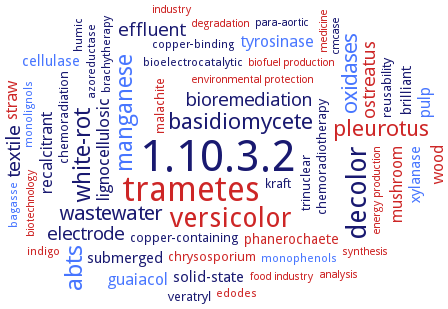1.10.3.2: laccase
This is an abbreviated version!
For detailed information about laccase, go to the full flat file.

Word Map on EC 1.10.3.2 
-
1.10.3.2
-
trametes
-
decolor
-
versicolor
-
abts
-
white-rot
-
manganese
-
basidiomycete
-
pleurotus
-
oxidases
-
wastewater
-
textile
-
effluent
-
ostreatus
-
bioremediation
-
electrode
-
lignocellulosic
-
recalcitrant
-
pulp
-
guaiacol
-
straw
-
wood
-
tyrosinase
-
mushroom
-
solid-state
-
submerged
-
cellulase
-
xylanase
-
brilliant
-
phanerochaete
-
chemoradiation
-
chrysosporium
-
malachite
-
trinuclear
-
veratryl
-
kraft
-
chemoradiotherapy
-
copper-containing
-
reusability
-
monophenols
-
indigo
-
edodes
-
humic
-
bagasse
-
brachytherapy
-
bioelectrocatalytic
-
copper-binding
-
azoreductase
-
monolignols
-
industry
-
para-aortic
-
food industry
-
degradation
-
biofuel production
-
energy production
-
medicine
-
environmental protection
-
biotechnology
-
analysis
-
cmcase
-
synthesis
- 1.10.3.2
- trametes
-
decolor
- versicolor
- abts
-
white-rot
- manganese
-
basidiomycete
- pleurotus
- oxidases
-
wastewater
-
textile
-
effluent
- ostreatus
-
bioremediation
-
electrode
-
lignocellulosic
-
recalcitrant
- pulp
- guaiacol
- straw
- wood
- tyrosinase
- mushroom
-
solid-state
-
submerged
- cellulase
- xylanase
-
brilliant
- phanerochaete
-
chemoradiation
- chrysosporium
- malachite
-
trinuclear
-
veratryl
-
kraft
-
chemoradiotherapy
-
copper-containing
-
reusability
- monophenols
- indigo
- edodes
-
humic
- bagasse
-
brachytherapy
-
bioelectrocatalytic
-
copper-binding
- azoreductase
- monolignols
- industry
-
para-aortic
- food industry
- degradation
- biofuel production
- energy production
- medicine
- environmental protection
- biotechnology
- analysis
- cmcase
- synthesis
Reaction
4 benzenediol
+
Synonyms
ATM, benzenediol oxygen oxidoreductase, benzenediol-oxygen oxidoreductase, benzenediol: oxygen oxidoreductase, benzenediol:O2 oxidoreductase, Benzenediol:oxygen oxidoreductase, blue laccase, blue multicopper oxidase, CcLCC6, CotA, CotA laccase, CotA-laccase, CotA-type laccase, CueO, DA2_0547, DcLac1, DcLac2, Diphenol oxidase, EpoA, Ery4, Ery4 laccase, FpLcc1, FpLcc2, GMET_RS10855, Hvo_B0205, LAC, Lac I, Lac II, Lac-3.5, Lac-4.8, LAC1, Lac2, Lac2a, LAC3, Lac4, LacA, Lacc, laccase, laccase 1, laccase 3, laccase A, Laccase allele OR, Laccase allele TS, laccase CueO, laccase POXA3b, laccase-2, laccase2, LacCh, lacTT, LacTv, LacZ1, Lcc, lcc1, Lcc2, Lcc3, Lcc4, Lcc9, LccA, lccdelta, lccgamma, Ligninolytic phenoloxidase, MAL, McoP, MmPPO laccase, MmPPOA, More, MSK laccase, multicopper oxidase, p-benzenediol:dioxygen oxidoreductase, p-diphenol dioxygen oxidoreductase, p-diphenol oxidase, p-diphenol: dioxygen oxidoreductase, p-diphenol:dioxygenoxidoreductase, p-diphenol:O2 oxidoreductase, p-diphenol:oxygen oxidoreductase, p-diphenol:oxygen-oxidoreductase, PCL, phenol oxidase, PM1 laccase, polyphenol oxidase A, POXA1b, POXA1w, POXA2, POXA3 laccase, POXA3a, POXA3b, POXC, PpoA, PsLac1, PsLac2, rlac1338, SLAC, SN4LAC, spore coat A protein, spore coat protein A, SRL1, SvLAC13, SvLAC15, SvLAC50, SvLAC52, SvLAC9, TaLac1, ThL, TTC1370, TthLAC, two-domain laccase, urishiol oxidase, urushiol oxidase, Wlac, YacK, yellow laccase


 results (
results ( results (
results ( top
top





